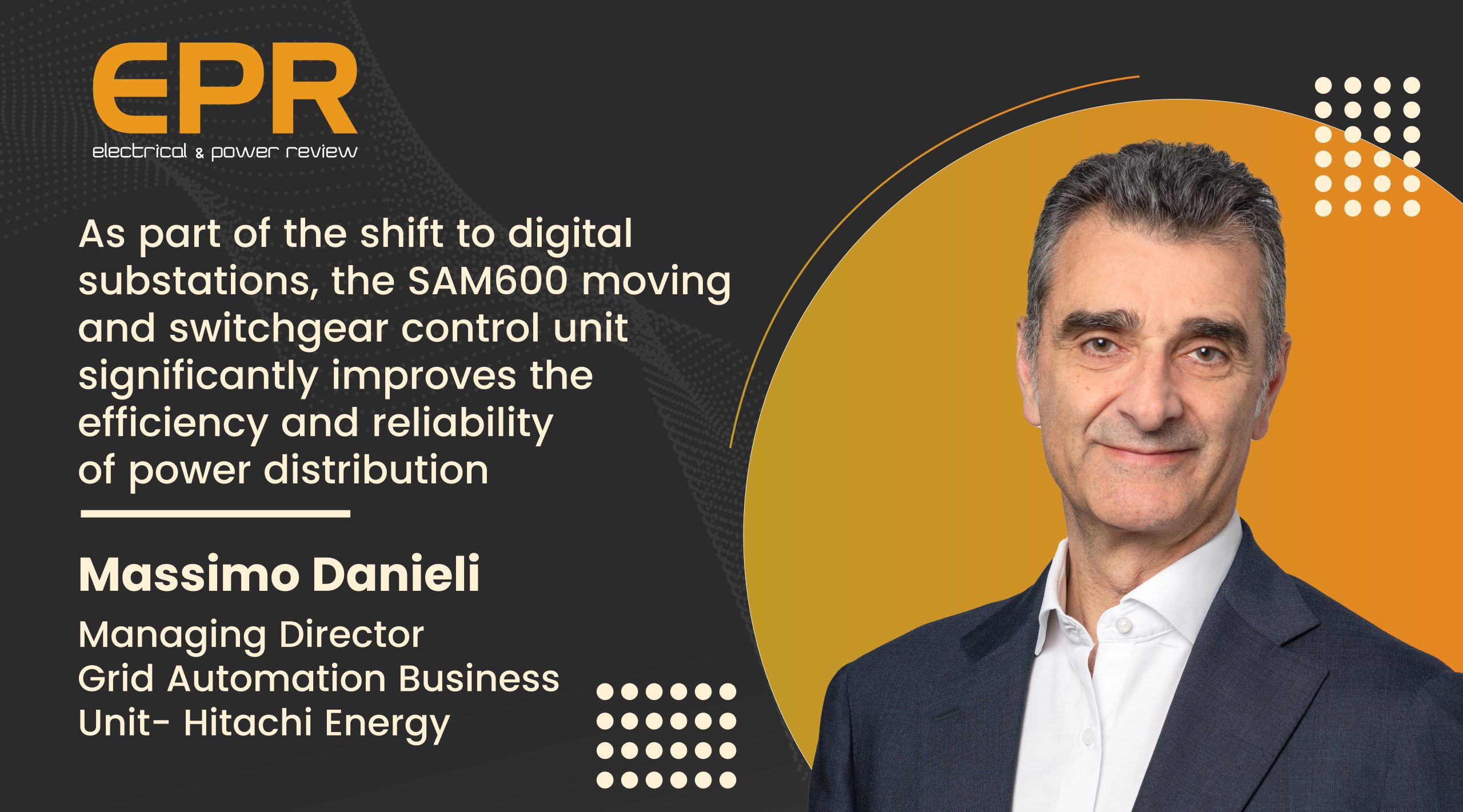Hitachi Energy leveraging AI, ML and cloud computing for grid modernisation
By EPR Magazine Editorial November 8, 2024 3:39 pm IST
By EPR Magazine Editorial November 8, 2024 3:39 pm IST

The key focus areas of Hitachi Energy will be strengthening energy distribution infrastructure in India. And as part of the shift to digital substations, the SAM600 moving and switchgear control unit is significantly improving the efficiency and reliability of power distribution.
Hitachi Energy has significantly modernised its Network Manager WAMS, enabling control room operators to proactively manage the grid, detect real-time disturbances before they cascade into serious disruptions or widespread blackouts, and maintain the grid’s stability and reliability today and in the future. Let us know more from Massimo Danieli.
All over the world, power grids are evolving into complex systems that will be harder to plan, build, operate, and maintain. In the India market, one of Hitachi Energy’s key focus areas will be strengthening India’s energy distribution infrastructure. As part of the shift to digital substations, the SAM600 moving and switchgear control unit significantly improves the efficiency and reliability of power distribution. The REF650, is an all-new relay that meets the demands of distribution automation and medium-voltage applications. System components like protection and control relays integrate critical data sources to operate distribution grids more autonomously and responsively.
We are also delivering software advancements to help utilities build tomorrow’s control centers. The dynamic nature of the expanding grid leads to faster and more frequent changes, requiring more proactive management. Our WAMS solution is ready for this challenge, combining high frequency data from the field into the control center operations, and integrates with Network Manager SCADA EMS in an enhanced user interface.
As the grid evolves, Hitachi Energy’s Energy Portfolio Management (EPM) solutions support critical energy investment decisions and efficient energy operations across planning, forecasting, trading, portfolio optimisation and market operations.
Grid modernisation demands more flexibility and resiliency, but this also means more complexity. AI and ML together can improve many aspects of grid performance—for example, in managing the network, we can apply AI to make the grid more reliable and responsive. In energy trading we are already creating sophisticated models with advanced computing give more insight into market behaviours and options than ever before.
Another example is vegetation management, which is essential to grid reliability and long-term resilience—but is an expensive, complex, and tedious process. Hitachi Vegetation Manager captures satellite imagery and field insights to analyse the data using artificial intelligence. It then makes optimised recommendations based on risks and business constraints.
Meeting renewable targets, adding distributed energy resources (DER), and the rapid addition of energy-intensive data centers will all require AI / ML and cloud computing, where the size of associated data sets becomes unmanageable by traditional algorithmic solutions and where speed required to take decisions cannot be managed by humans or even by traditional computing schemes. There are also enormous opportunities available through the combination of information technology (IT), operational technology (OT), and services, which we offer to help our customers as they navigate their own digital transformations.At Hitachi Energy, we believe in the power of connections and partnerships across all stakeholders within the tech ecosystem, including with the wider Hitachi network, as well as customers, academia, institutions and governments.
For example, with mounting international pressure to deliver on climate commitments, countries are looking for solutions to decarbonise quickly and show evidence of their progress. Speed and Scale are emerging as key challenges that Hitachi Energy is uniquely positioned to address. We also see the industry stepping up, and we are encouraged to see government action, both in terms of policy and regulatory initiatives, as well as funding to support infrastructure projects.
Hitachi Energy has significantly modernized its Network Manager WAMS, enabling control room operators to proactively manage the grid, detect real-time disturbances before they cascade into serious disruptions or widespread blackouts, and maintain the grid’s stability and reliability today and in the future. Hitachi Energy has:
With the rapid increase in converter-based renewable sources, it is crucial to arm control room operators with a real-time readout of unplanned variations in voltage or currents. Phasor measurement units (PMU) provide high-frequency, high-resolution visualizations of power system dynamics. Through its WAMS, Hitachi Energy has put PMU data in the hands of control room operators.
The company is combining traditional energy management system (EMS) measurements with high-resolution PMU data points, giving operators enhanced awareness of the dynamic state of the power system through real-time visualizations of sub-synchronous oscillations, system interactions, and voltage angle stability.
Hitachi Energy has integrated Network Manager WAMS with its supervisory control and data acquisition (SCADA) and EMS to grant operators access to all the information through a single pane of glass. This unique integration brings new, advanced indications into the operator environment and enables operators to directly use PMU measurements and high-frequency WAMS calculations within existing EMS applications, such as state estimation, parameter estimation, and voltage stability analysis.
Integrating WAMS with EMS and providing access to network model data opens the door to advanced PMU-based applications, such as oscillation and stability monitoring, linear state estimation, inertia monitoring, and fault location, among others. Operators gain an early warning of unsafe operating conditions and can deploy reserves and classic generation to shore up inertia and avert disruptions and catastrophic power blackouts.
To ease access and administration and improve usability and reaction time for grid operators, Hitachi Energy has developed an intuitive, modern user interface (UI) that unifies SCADA/EMS and WAMS into a single view – believed to be the first common UI in the marketplace. This powerful UI assists operators in daily operations and gives them the unified visibility they need to manage the grid proactively.
We use cookies to personalize your experience. By continuing to visit this website you agree to our Terms & Conditions, Privacy Policy and Cookie Policy.